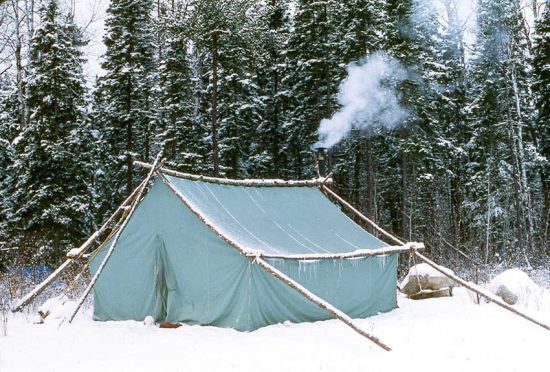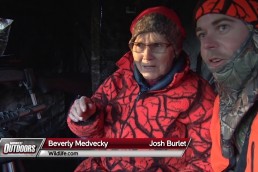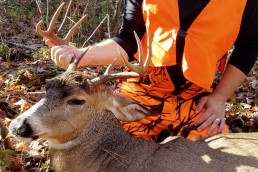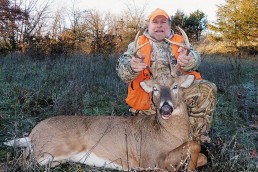Deer Hunting for Old-timers
SHARE THIS POST
Beginning last fall while scouting or hiking to and from stand sites, recurring pain in my lower legs and my hips made it necessary to halt about every 75 yards or so to rest a few minutes (not good hunting technique). I blamed it on old age and being out of shape. A subsequent echocardiogram and stress test revealed something more serious was happening. After nearly 81 years, the defective aortic heart valve I was born with had calcified to the extent that it could no longer open and close as it should. My heart could no longer pump adequate blood to the muscles of my legs and who knows what else. If I hadn’t had open-heart surgery to replace that valve three weeks ago, it is doubtful I would have enjoyed another deer hunting season.
Another deer hunting season?

If my wife Jene were still alive today (she suddenly passed away three years ago), further deer hunting for me would have been in great peril right now. Her campaign to finally get me to quit would have been furious and it is very difficult to out-stubborn an Irish woman determined to keep her husband from dying in the woods (as non-hunting wives tend to believe will happen). With or without a wife’s influence, nonetheless, all deer hunters eventually come to the crossroads where a terrible question must be answered: Should I quit deer hunting?
Though I may never again do extensive scouting, hang a portable stand in a tree, help drag a buck to camp, hike two miles in total darkness to or from a stand site, set up my big wall tent with its outside spruce pole frame or cut, split and stack firewood, and after much discussion with my sons who insist I should be in camp even after I can no longer hunt, my current answer to this question is—not yet.
With my family of hunting partners promising to take over all heavy-duty camp chores and now having the first normally-functioning heart I’ve had in a lifetime, I’m convinced I will be able to continue to enjoy most of the deer hunting adventures I have been experiencing since 1945. Moreover, I will also be able to continue my lifelong hunting-related studies of whitetails, some of which are still ongoing. It’s going to be different though, as physically capable as I may be following months of cardiac rehabilitation, I’ll still be 81 and well beyond the age when most deer hunters hang up their big boomers.
Thoughts of a heroic white-haired man I came across in the woods one hunting season long ago keep providing me with considerable encouragement, however. He was sitting on the trunk of a fallen cedar tree next to a pair of crutches about 100 yards south of the nearest logging trail.
“Seen any deer?” I asked him.
“Three,” he said, grinning. “Got two of them. Take a look at the big 10-pointer I dropped an hour ago; it’s on the ground just on the other side of those roots sticking up at the end of this tree. The other deer was an 8-pointer. It ran off and my son went after it. He came back one half hour ago to tell me he found it. He should be dragging it this way soon.”
Are you enjoying this post?
You can be among the first to get the latest info on where to go, what to use and how to use it!
“Incredible,” I murmured. “How old are you?” I asked.
“A young 93,” he answered, laughing. “Can’t walk without crutches any more, but I can still hunt deer.”
So, convinced I too can still hunt deer, here I sit trying to imagine what I must do to enjoy additional years of deer hunting in ways appropriate for someone my age. From now on, for example, I plan to pair up with a hunting partner each day, the two of us heading out from camp together each morning or noon, splitting up when drawing near our well-separated stand sites and then meeting again when it’s time to head back to camp. This will ensure someone will always know exactly where I am stand-hunting and I will always have a partner within hailing, police-whistle or walkie-talkie distance (in an area with no cellphone service) if I need assistance.
From now on, most or all of my stand sites will be located within one-half mile of camp. All will be ground level (no more tree climbing). I will sit on my backpacked hunting stool with my back to a tree trunk, well hidden by natural, unaltered cover in front and behind me. My stand site approach trails will provide easy, though hidden, access from downwind or crosswind.
For the first time in my life, I’m planning to purchase one of those portable, pop-up camo tents referred to as ground blinds, thinking extra protection from snow, frigid winds and motion-sensitive eyes of nearby whitetails would be advantageous for an old-timer with few stand sites. Rather than place my blind where its unnatural (cube-like) form might be recognized as something likely to be dangerous by experienced whitetails, my blind will always be closely surrounded by plenty of natural forest cover at least 15 to 25 yards from the edges of potentially productive openings such as whitetail feeding areas, clearcuts or farm fields (never placed right next to them). Weighing only 20 pounds or so, the one I have in mind should be easy to fold and set up at a new site every day or half-day—a setup in the evening for hunting the following morning and a setup midday for hunting later in the afternoon and evening.
In addition, I plan to take a break from hunting now and then. Being the least productive time, afternoon hours would be best. I may even occasionally take an entire day off. While in camp, I’ll no doubt do some modified stand-hunting: scanning surroundings with binoculars while seated inside my portable hide-away (blind) set up near the big tent. Actually, the odds of taking a buck in camp might be fairly good. A few years ago my son, Ken, proved it could be done—taking a buck while seated on our deer camp latrine. I don’t recall a hunting season during which we did not occasionally discover very fresh tracks of whitetails that had passed within 50 yards of our tent, sometimes even spotting fresh rubs and scrapes. And last year, a moose stopped only 30 yards away. Right now I can even visualize at least four potentially productive stand sites within 100 yards of our camp. I may not have a monster buck living two miles away to hunt this year, but I know I’ll occasionally spot does near camp. And while any one of them is in heat, the odds of seeing an accompanying dominant buck will be as favorable as anywhere else.
Actually, the “hunting” part of deer hunting has always been only half of what I have long considered to be the best part of the experience. The other half is life in winter deer camp amidst these animals we hunt. This part will be unchanged. As long as pine logs are crackling, popping and mewing in our double-barrel wood stove, a new and less physically demanding hunt close to camp will be just fine.
Dr. Ken Nordberg has written more than 700 magazine articles and 12 books on the habits and hunting of whitetails and black bears, including the “Whitetail Hunters Almanac” series. He also produced “Doc’s Buck and Bear Hunting School” videos. His encyclopedic website is at drnordbergondeerhunting.com.
MWO
SHARE THIS POST
Did you enjoy this post?
You can be among the first to get the latest info on where to go, what to use and how to use it!



